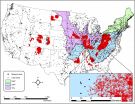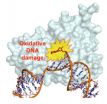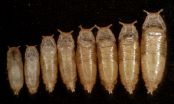(Press-News.org) Anglers across the nation wondering why luck at their favorite fishing spot seems to have dried up may have a surprising culprit: a mine miles away, even in a different state.
Scientists at Michigan State University (MSU) have taken a first broad look at the impacts of mines across the country- and found that mining can damage fish habitats miles downstream, and even in streams not directly connected to the mines.
The work is published in this week's issue of the journal Ecological Indicators.
"We've been surprised that even a single mine in headwaters might influence larger rivers miles downstream," said Wesley Daniel, a research associate at Michigan State University. "Mines have a much stronger influence on fishes than has been assumed. It's important, when considering the location of a new mine, to not just look local - but look way downstream."
Mining occurs in every state for a variety of natural resources - such as coal, precious metals, pebbles, sand and salt. Mining disrupts the environment around it, Daniel said. It can add sediments and chemicals to rivers, alter the flow of streams, lead to fewer forests in headwaters, and compact soil - all of which can change fish habitats.
And what happens to the river or stream near the mine flows downstream and can wreak havoc on populations of trout or bass and the smaller fishes that they prefer, far from the mine's location. The study looked at areas throughout the eastern United States typically known for mining, such as Appalachia, but also included areas where little mining research has been done, such as Iowa and Illinois
Daniel works in the lab of Dana Infante, associate professor of fisheries and wildlife who studies the way landscape and land use affect water. Colleagues in her lab recently developed an algorithm capable of crunching the mountains of data that tell the connected stories of the nation's streams and rivers.
That algorithm has allowed Daniel to take a long look at how extensive the effects of mines on rivers can be. His conclusion calls mines a "regional stress" and cites the example of pollutants from a mine in a headwater stream in Kentucky disrupting the breeding grounds of bass in Tennessee rivers.
While large rivers can dilute the damage a mine may do, the small streams that feed into a watershed may be much more fragile.
"The quality of headwater streams will determine quality of rivers," Daniel said. "The condition of small streams that flow into larger rivers will affect downstream fish communities. Everything is cumulative -- again and again we can see that the effects of one mine can be associated with altered fish communities."
Along with Daniel and Infante, "Characterizing coal and mineral mines as a regional source of stress to stream fish assemblages" was written by Robert Hughes at Amnis Opes Institute; Yin-Phan Tsang, Daniel Wieferich, Kyle Herreman, Arthur Cooper and William Taylor at MSU; Peter Esselman at the U.S. Geological Survey Great Lakes Science Center in Ann Arbor, Mich.; and Lizhu Wang of the International Joint Commission Great Lakes Regional Office in Detroit.
Infante, Tsang, Esselman and Taylor are affiliated with the MSU Center for Systems Integration and Sustainability, an interdisciplinary research center that works in the innovative new field of coupled human and natural systems to find sustainable solutions that both benefit the environment and enable people to thrive.
INFORMATION:
The research was funded by the U.S. Fish and Wildlife Service and the U.S. Geological Survey.
Australian average incomes are falling with the country's population growth "masking underlying economic weakness", according to a QUT economist.
Dr Mark McGovern, a senior lecturer in QUT's Business School, said while it was regularly proclaimed Australia had experienced positive economic growth for more than 20 years, there had been periodic per capita declines, indicating the economy was not as healthy as assumed.
"Looking at national income figures in recent years shows our economy is under stress," Dr McGovern, whose research was recently published in the Economic ...
Few agribusinesses or governments regulate the types of plants that farmers use in their pastures to feed their livestock, according to an international team of researchers that includes one plant scientist from Virginia Tech.
The problem is most of these so-called pasture plants are invasive weeds.
In a Proceedings of the National Academy of Sciences study this month, the scientists recommended tighter regulations, including a fee for damage to surrounding areas, evaluation of weed risk to the environment, a list of prohibited species based on this risk, and closer ...
Using a new imaging technique, National Institutes of Health researchers have found that the biological machinery that builds DNA can insert molecules into the DNA strand that are damaged as a result of environmental exposures. These damaged molecules trigger cell death that produces some human diseases, according to the researchers. The work, appearing online Nov. 17 in the journal Nature, provides a possible explanation for how one type of DNA damage may lead to cancer, diabetes, hypertension, cardiovascular and lung disease, and Alzheimer's disease.
Time-lapse crystallography ...
PHILADELPHIA (Nov. 25, 2014) - As the linked epidemics of obesity and diabetes continue to escalate, a staggering one in five U.S. adults is projected to have diabetes by 2050.
Ground zero for identifying ways to slow and stop that rise is Philadelphia, which has the highest diabetes rate among the nation's largest cities. For public health researchers at Drexel University, it is also a prime location to learn how neighborhood and community-level factors -- not just individual factors like diet, exercise and education-- influence people's risk.
A new Drexel study published ...
PITTSBURGH, Nov. 24, 2014 -Barriers to the sharing of public health data hamper decision-making efforts on local, national and global levels, and stymie attempts to contain emerging global health threats, an international team led by the University of Pittsburgh Graduate School of Public Health announced today.
The analysis, published in the journal BMC Public Health and funded by the Bill & Melinda Gates Foundation and the National Institutes of Health (NIH), classifies and examines the barriers in order to open a focused international dialogue on solutions.
"Data on ...
The proper regulation of body size is of fundamental importance, but the mechanisms that stop growth are still unclear. In a study now published in the scientific journal eLife*, a research group from Instituto Gulbenkian de Ciência (IGC), led by Christen Mirth, shed new light on how animals regulate body size. The researchers uncovered important clues about the molecular mechanisms triggered by environmental conditions that ultimately affect final body size. They show that the timing of synthesis of a steroid hormone called ecdysone is sensitive to nutrition in the ...
People's views on income inequality and wealth distribution may have little to do with how much money they have in the bank and a lot to do with how wealthy they feel in comparison to their friends and neighbors, according to new findings published in Psychological Science, a journal of the Association for Psychological Science.
"Our research shows that subjective feelings of wealth or poverty motivate people's attitudes toward redistribution, quite independently of objective self-interest," says psychological scientist and study co-author Keith Payne of the University ...
WASHINGTON, Nov. 25, 2014 -- Your beer may attract annoying fruit flies, but listen up before you give them a swat. Researchers found the yeast cells in beer are producing odor compounds -- acetate esters -- that lure flies and that could lead to the best beer you haven't even tasted yet. This week's Speaking of Chemistry explains why. Check it out at http://youtu.be/HQNlGuZvCvA.
Speaking of Chemistry is a production of Chemical & Engineering News, a weekly magazine of the American Chemical Society. The program features fascinating, weird and otherwise interesting chemistry ...
Bitcoin is the new money: minted and exchanged on the Internet. Faster and cheaper than a bank, the service is attracting attention from all over the world. But a big question remains: are the transactions really anonymous? Several research groups worldwide have shown that it is possible to find out which transactions belong together, even if the client uses different pseudonyms. However it was not clear if it is also possible to reveal the IP address behind each transaction. This has changed: researchers at the University of Luxembourg have now demonstrated how this is ...
The study at Sahlgrenska Academy, University of Gothenburg, was based on the Swedish National Epilepsy Surgery Register, which includes all cases since 1990. The researchers reviewed data for the 865 patients who were operated on at Sweden's six epilepsy surgery clinics from 1996 to 2010.
The purpose of surgery is to enable a person with severe epilepsy to be free of seizures or to reduce their frequency to the point that (s)he can enjoy better quality of life.
Downward trend
Only 3% (25) of the patients suffered lasting complications. A comparison with a previous ...







